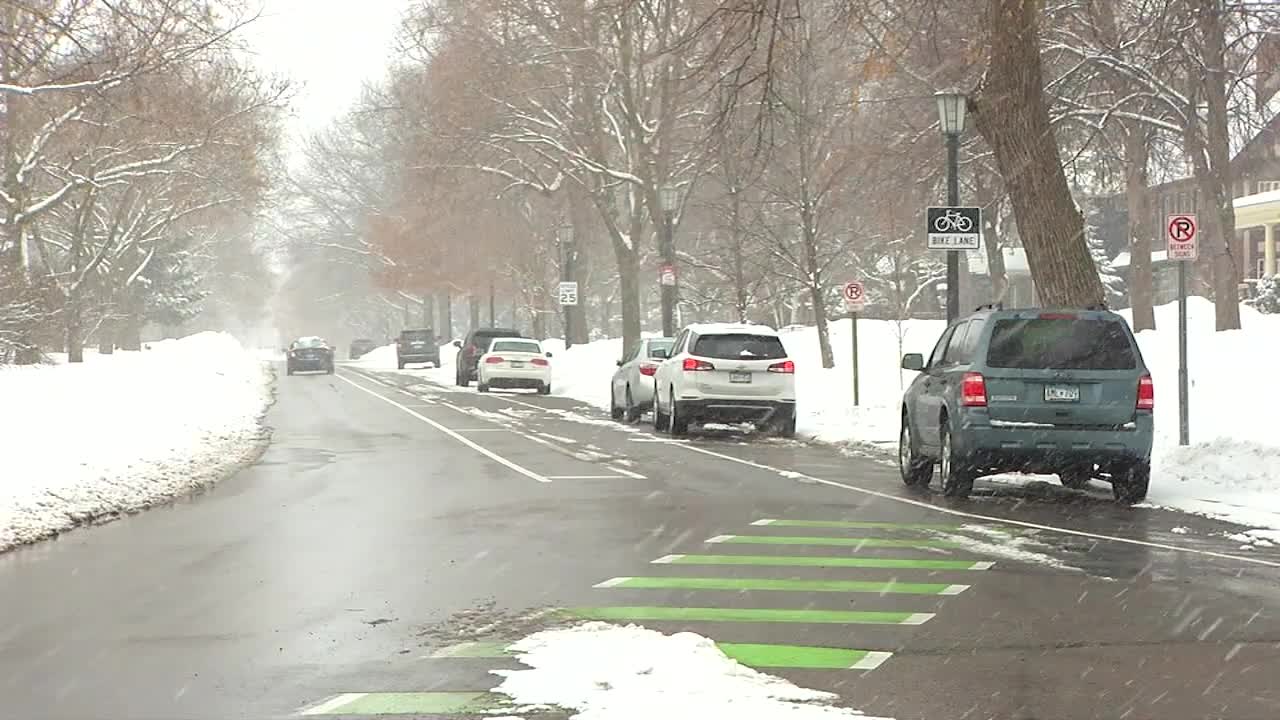St. Paul’s Summit Avenue bike path plan met with safety, preservation debate
[anvplayer video=”5167133″ station=”998122″]
In the name of safety for bicyclists and pedestrians, St. Paul Parks and Recreation officials want to build a 4.5-mile bike path on Summit Avenue, but a group started by residents of the street say the city is not considering the health of the historic corridor, and its many mature trees.
Construction of a raised path that would be separated from the road by a curb is at least five years out, but the core plan will be up for a vote in April. Currently, there are strong feelings in support and opposition.
Traffic levels on the majority of Summit Avenue call for a separated bike lane or a side path, according to city traffic studies and bikeway guidelines from the Federal Highway Administration. As it stands, there’s a painted lane for bikers placed between parked cars and the road.
From 2015 to 2019, the Minnesota Department of Public transportation recorded 283 vehicle crashes on Summit Avenue, including vehicle to vehicle, vehicle to fixed object, vehicle to pedestrian and vehicle to bicyclist.
When asked if it was an unusually high number for a St. Paul city street, Parks and Recreation director Andy Rodriguez said, “I would say any type of number like that is concerning.”

(KSTP)
As local grassroots group Save Our Streets has pointed out, reconstructing the road would mean knocking out a number of trees rooted under the existing street.
“Aesthetically, this is unique because of the old trees, but it’s not just aesthetics,” said Summit Avenue resident Bob Cattanach, who is a member of a growing movement with an online petition that’s received thousands of signatures.
“The net environmental effect is huge, and we’re not taking that into account at all,” Cattanach said.
When forecasting the number of trees at risk of being killed off by the project, Rodriguez provided context: “It’s important to mention that over the past decade, we’ve removed 500 trees from Summit Avenue. Like that’s for various purposes, whether it’s emerald ash borer, the health of the tree, other things.”
He added, “I think we’d be looking at a vulnerability of, I think it’s around 8% along the corridor.”
Rodriguez called that 8% a rough estimation on a long-range reconstruction plan that goes far beyond a bike path. The road and the utilities underneath it need an overhaul, and path or not, trees will be affected, said Public Works director Sean Kershaw.
“I’ll be very blunt,” Kershaw said. “Save Our Streets is saying that the road doesn’t need to be reconstructed. And there is no civil engineer in Minnesota that will say that Summit doesn’t need to be reconstructed.”
There’s another layer to the opposition: Parking.
The stretch of Summit Ave starting at Lexington Avenue and traveling east just beyond the Cathedral of St. Paul would go from two-sided parking to one-sided.
“I’m extremely concerned about the removal of any street parking because it’s so precious to begin with,” said The Rev. John Ubel following Mass one Sunday.
In reference to a parking study, the city’s plan says 30% of Summit’s parking spaces are being used on average. The Cathedral may be an outlier, however, as best demonstrated by its bumper-to-bumper parking lot on a Sunday morning,
“Parking has always been a challenge at the Cathedral,” Ubel continued.
“We only have about 130 spots for a church that seats well over 2000 people comfortably. And we also host over 30 major events every year.”
Save our Streets presented alternatives, including using high visibility paint on the existing lanes. The city is adamant about its proposed raised paths, and so is St. Paul bicyclist Andy Singer.
“The issue is not visibility. The issue is space and where you’re biking and its maintainability,” Singer said in an interview Sunday.
“People get hit.”
For Singer, his bike is his primary means of transportation. He said as is, the paths aren’t well maintained for long stretches in the winter, or people park in them as the snowbanks shrink the curbs.
“You would be biking along on a path as opposed to biking between speeding traffic and automobile door zones,” Singer said in support of the city’s plan.
The St. Paul Parks and Recreation Commission is set to vote on the draft plan at the next meeting on April 13. A public comment period is also on the commission’s agenda.
As for construction, that’s at least five years out, Kershaw said, adding Public Works is still solidifying how to fund it.